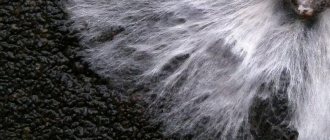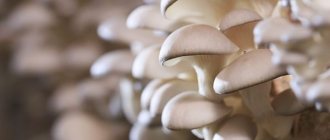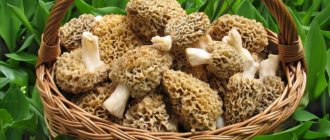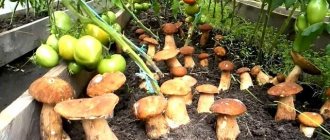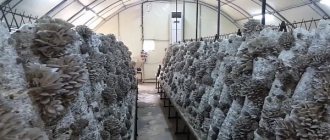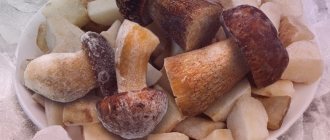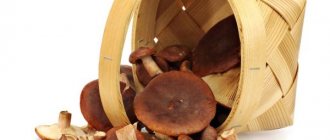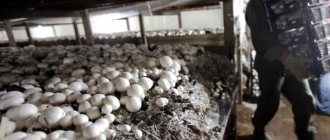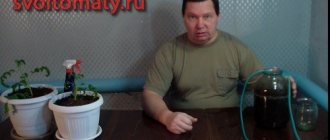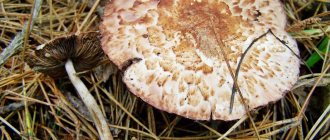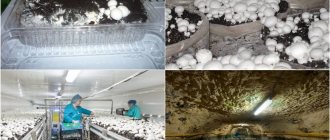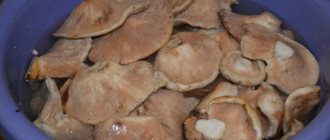Mushrooms
0
1241
Article rating
Kira Stoletova
Mushrooms classified as a separate kingdom have a special structure and vital activity. An important role in the life of fungi is played by the mycelium - a branched underground or partially protruding organ that provides the fruiting body with access to nutrition and fixation in the environment.
The structure of mushroom mycelium and its cultivation
What is Mycelium
What is fungal mycelium is spores, that is, the very seed of the disease. Microspores can appear both on any external area and on internal organs. The question arises, what is it when you see changes in the cover in the form of thin threads - this is the mycelium of mushrooms.
Once the pathogenic grain enters the body, it begins to gradually stretch out, forming a hollow tube. Then its walls become thinner and scattered over a large area, the mycelium first transforms into a hypha. A simple and clear example of hyphae is mold. And after this, mushrooms begin to appear in rich scattering.
What mushrooms are grown from mycelium?
If you have a summer house or a personal plot, then, in addition to vegetables and fruits, you can also grow mushrooms on it - a delicious product that will diversify your diet. And if you get the hang of it, you can go big and grow mushrooms for sale. And not only traditional oyster mushrooms and champignons, but also honey mushrooms, boletus mushrooms, and other mushrooms with good taste and yield. Let's find out which mushrooms are best grown from mycelium.
Champignon
Champignon is a mushroom, the most popular in mass production. There are three types of champignons - white, cream and brown. The easiest way to grow white champignons from mycelium is that they are less capricious and produce seven harvests per year. For successful cultivation you need:
1. Create favorable temperature and humidity in the greenhouse.
2. Prepare a special substrate. To prepare it you will need:
- chopped straw of winter grains;
- horse, cow, rabbit or pig manure;
- urea;
- lime, chalk or gypsum.
The substrate is prepared following the following proportions:
- straw – 100 kg;
- manure – 50 kg;
- urea – 300 g;
- water – 300 l.
It is advisable to add superphosphate - 300 g. The compost is laid out on the film, stirring and moistening for 10 days. It is necessary to ensure that there is no excess of ammonia and carbon dioxide in the substrate.
3. The finished substrate is laid out in boxes - a layer of 20 cm.
4. Prepare mycelium:
- Grain. Place the grain mixture in a metal bowl and pour in water - it should cover by 2-3 cm. Cook for 1 hour. After straining the grain, it is dried. Pour into jars, filling them 50%. Sterilized. Place some mycelium in the cooled jars. When white fluff appears, it will become clear that the mycelium is developing successfully. After a week, the finished mycelium can be planted.
- From mushroom legs . Soak the corrugated cardboard for 1 hour. Cuts are made on the stem of the mushroom and divided into fibers. Drainage holes are made in the container for the “farm”. Mushroom fiber is placed on the soaked cardboard, covered with wet cardboard - it is removed from above, and a press is placed. When the leaf turns white, the mycelium is ready and can be placed in the nutrient mixture.
5. Place the mycelium in the substrate. Cover the boxes with paper. The mycelium will begin to germinate in 2-3 weeks.
Oyster mushrooms
This productive and unpretentious mushroom is grown on:
- hardwood;
- in bags with substrate - it is prepared from sunflower husks, sawdust and straw.
For planting you need high-quality mycelium. Healthy oyster mushroom mycelium is white or cream in color. To the touch - dry. It is purchased in late autumn or early spring - before the temperature rises above +3°C. Procedure for growing oyster mushrooms:
- Preparing the premises - for example, a greenhouse.
- Planting can begin in November, then the first mushrooms will be obtained by the end of winter.
- Preparation of logs. Take cuttings - up to 0.5 m long, 40 cm in diameter. Dry wood is soaked for 2 days. Fresh wood is not soaked.
- The finished trimmings are infected with mycelium. For this purpose, each cut is generously sprinkled with mycelium - a layer of about 1 cm. Four logs are stacked on top of each other. Cover with burlap or sprinkle with sawdust. The distance between the bars is at least 40 cm.
- The room temperature is maintained at +13-+15°C. Humidity – 90%. Oyster mushrooms do not like light - if there is too much of it, the mycelium may die. After the start of fruiting, you need to increase the temperature to +25°C. From one stump you get 0.5-2.5 kg of mushrooms.
In addition to logs, you can use bags for growing oyster mushrooms:
- The material is used of one type or in the form of a mixture.
- The crushed raw materials are placed in an enamel container and poured with boiling water for 12 hours.
- Drain the water and squeeze out the raw material.
- After mixing the substrate with mycelium, fill bags with the mixture.
- Make holes in the bags so mushrooms will grow through them.
A specialist mushroom grower talks about all the stages of growing oyster mushroom mycelium at home:
Porcini
Porcini mushrooms are not grown indoors. They need a site where birch, pine or oak trees grow. Procedure for growing boletus mushrooms:
- Planting can be done between late spring and early autumn. It should be warm outside.
- To prepare the mycelium, take the hats of healthy, ripe boletus mushrooms. The hats are soaked for 2 hours - fill them with clean cold water. Then add sugar - 200 g and break into pieces. After this, the hats lie in sweetened water for another 2 hours.
- Remove 20 cm of the top layer under the trees (under which the mushrooms will grow), pour out the finished mycelium. The first mushrooms will appear in a year. It is important to maintain optimal humidity. If the soil is waterlogged, the mycelium will begin to rot.
Honey mushrooms
It is not possible for everyone to grow honey mushrooms on a plot right away. The procedure for growing honey mushrooms from mycelium:
- Wood harvesting - it is transferred to the planting site. The site is selected so that there is no wind and sun.
- Mycelium is prepared from the fruiting bodies of mushrooms in the usual way, or you can buy it ready-made. You can put mycelium sticks into wood.
- In order for the mycelium to penetrate the soil, chocks are dug to 2/3 of the height. The interval between the chocks is 10-15 cm.
- From the moment the substrate is infected with mycelium until fruiting, 45 days pass.
It is recommended to plant honey mushrooms in open ground in the spring - in trunks saturated with moisture and nutrients.
Growing mycelium at home complicates the already difficult process of growing mushrooms. Buy a mycelium or grow it yourself - each mushroom grower decides for himself.
0
0
Copy link
Types of Mycelium
The species of the pathology is determined by a fragment taken from the carbohydrate material that makes up the growth.
The following groups are distinguished:
- Ascomycetes are varieties of:
- yeast-like
- moldy,
- dermatophytes.
- Zygomycetes.
- Basidiomycetes.
- Deutremycetes.
These are four groups out of eight, but they are the ones that pose the greatest threat to health.
And it doesn’t matter where any classification of fungi in the form of mycelium appears, the occurrence of pathology cannot be traced on the internal organs, but the changes seen on the nails are a signal of distress.
Types of planting mycelium
To get an abundance of boletus, white, and chanterelles on your site, you need to stock up on planting material. Suitable:
- grain mycelium;
- liquid mycelium;
- mycelium on wooden sticks.
The grain type of mycelium has advantages and disadvantages. Plus - the grains are light and dry material. It is used to saturate the substrate with seeds (spores). Suitable for growing fruiting bodies on soil and sawdust. Disadvantage - it only works in conditions of technological landing.
If you need to plant fruiting bodies in natural conditions (on tree bark), stick hyphae are suitable. They infect wood cuts, and the fungus is cultivated in its natural environment on stumps. Disadvantage - it is impossible to obtain large volumes of the product; it is only suitable for deciduous trees.
Liquid mycelium first grows in a nutrient medium - honey, fructose. Then it is moved to the external environment. The use of sealed containers and a nutrient substrate allows you to avoid the appearance of mold.
It is recommended to store the workpieces:
- in the refrigerator at a temperature from -1 to +3℃ for no more than a month;
- at 5℃ no more than 3 weeks.
Violation of storage conditions leads to the fact that the cultivation of fruit mycelium is ineffective due to cell death or their premature germination.
Mycelium threads on nails, what are they?
Mycelial threads on the nails are a sign that the immune system is weakened and the functional system was unable to repel the attack of pathogens. Because a phenomenon such as mycelium has free access to its target, in most cases, the internal rapid response team does not work properly.
And so that the nail layer is not destroyed, the nail plate should be saved immediately.
Mysteries of a special kingdom
Mushrooms are special and wonderful creatures. So much so that biologists have separated them into a separate kingdom - the Kingdom of Mushrooms - diverse, mysterious and, to this day, full of secrets and mysteries. Currently, scientists know about 100 thousand species of mushrooms, but this is only part of their huge world. The constant study of the vast expanses of the Kingdom of Mushrooms by mycologists continues to this day, and will bring many more discoveries.
We are all accustomed to collecting and eating edible mushrooms, without really thinking about how they are structured, but for an inquisitive seeker, information about their structure will not be superfluous at all.
Mysteries of the mushroom kingdom
What do mushrooms and animals have in common?
Fungi are special organisms that occupy a unique place between the plant and animal kingdoms. They are heterotrophs, like animals, that is, they cannot independently synthesize organic substances from inorganic compounds, like plants, but must receive nutrients from the external environment. In addition, they have the following properties in common with animals:
- Presence of chitin in the cell wall.
- Lack of plastids.
- The presence of lysosomes containing digestive enzymes.
- Presence of small storage vacuoles.
- Glycogen is used as a reserve nutrient rather than starch.
What do mushrooms and plants have in common?
In terms of their lifestyle, mushrooms are still more similar to plants. For a long time they were classified as part of the plant kingdom. They are similar to plants:
- Growing in one place
- Nutrition through the process of absorption, that is, the absorption of nutrients.
- Opportunities for unlimited growth.
- Reproduction by spores.
- Presence of a cell wall.
- Absence of a cell center.
- Presence of vacuoles in the cell.
What are mushrooms made of?
Mono- or multinucleated fungal cells are usually covered with a thin cell membrane. Underneath it is a cytoplasmic membrane that envelops the cytoplasm.
The fungal cell contains proteins, enzymes, and lysosomes, in which proteins are broken down by proteolytic enzymes. Mitochondria have general similarities with those of higher plants. Vacuoles contain reserve nutrients: fats, glycogen, lipids, fatty acids.
Edible mushrooms contain many vitamins and mineral salts. Approximately 50% of their dry mass is nitrogenous substances, of which proteins account for about 30%.
In our world, mushrooms are everywhere - from microscopic mold to giants a meter tall. They live wherever living organisms can live, and their role in the cycle of life is enormous. Fungi are decomposers—organisms that feed on dead organic remains and mineralize these remains into simple organic compounds.
Many types of fungi live in symbiosis with higher plants, forming mycorrhizae with their root system. Like boletus with birch.
Some higher plants cannot grow normally without mycorrhiza. Fungi receive oxygen, root secretions and nitrogen-free compounds from higher plants, and in return help them absorb hard-to-reach substances from humus, activating the activity of higher plant enzymes. They also contribute to their carbohydrate metabolism, fix free nitrogen, and provide growth substances and vitamins to higher plants.
Subkingdoms of mushrooms
The mushroom kingdom is divided into two subkingdoms:
- The lower ones are composed of one cell.
- Higher ones have multicellular mycelium.
Mechanism of transmission of nail fungus
Infection with pathogenic fungal spores can occur through any contact with an infected object. The mycelia of the fungus, getting on the nails, begin to conduct active occupying activities, trying to settle in a new place as soon as possible.
Infection can occur even with a normal handshake if basic hygiene is not observed. Although the danger of disease also arises when a person works for a long period in a humid environment. To minimize the risk of acquiring long and difficult treatment, it is necessary to follow sanitary recommendations.
Useful properties, application and restrictions on use
Mushrooms are an irreplaceable part of the earth’s ecosystem, without which many plants cannot develop. Mushrooms are also widely used in many areas of human activity, most often in medicine and cooking.
Symbiosis of fungal mycelium and roots of a higher plant
The symbiosis of a plant and a fungus is called mycorrhiza. This coexistence benefits both organisms. Thanks to mycorrhiza:
- the plant consumes soil resources as much as possible, and its root system has less load;
- mycorrhiza improves the quality of the soil, ensures its aeration and increases porosity.
Mycorrhiza
Mycorrhiza is divided into ectomycorrhiza and endomycorrhiza. Ectomycorrhizae include basidial or ascomycete species and temperate forest trees. This subtype of symbiosis has a positive effect on tree growth.
Endomycorrhiza is the fungal part at the root of a tree. The arbuscular type of endomycorrhiza is significant. This type of symbiosis is considered one of the most important on the planet and represents a connection between fungal tree-like threads and the cortical cells of the tree root.
In medicine
Mushrooms have become widespread in medicine thanks to the polysaccharides they contain. The antibiotic penicillin is made from penicillium, which is used to treat bacterial diseases in humans.
Use of mushrooms in medicine
In medicine, it is used to prepare laxatives, antituberculosis, and antityphoid drugs. In folk practice, extracts and decoctions are often prepared. Tinctures and extracts of red fly agaric are often used to treat rheumatism and inflammatory processes on the skin.
On the other hand, when certain types of fungi are detected in a smear taken from human mucous membranes, it indicates the development of serious diseases that require immediate treatment.
In nutrition
Mushrooms are also widely used in cooking. The fruit bodies of cap species are eaten pickled, fried or boiled. Experts recommend carefully selecting specimens, choosing only those that you are sure of.
Important!
Before cooking, it is necessary to heat treat not only conditionally edible, but also edible species. This requires cooking for 15-20 minutes in boiling water. Growing edible species in the country or at home is considered a more difficult task. To do this, you need to purchase mycelium, choose a suitable location and maintain the necessary conditions.
The main signs of mycelium on nails
The most common signs of the appearance of mycelium threads on nails are as follows:
- characteristic longitudinal change in the structure of the nail plate,
- plate fragility increases,
- the color changes dramatically, turning to shades of brown and yellow; in advanced cases, it becomes black,
- stripes and spots stretching to the level of the cuticle,
- unpleasant smell,
- burning and severe itching.
Such changes indicate that the fungus has settled on the body.
Mushroom structure
The cap and stem are the fruiting body. And the “working” part - the mycelium or mycelium - is located inside the wood, soil or substrate. The fruiting body does not live long, about 10-15 days. The mycelium can live even hundreds of years. It is resistant to low temperatures and drought.
Under unfavorable conditions, the mycelium stops its development. Under suitable conditions, the mycelium “wakes up” and continues to grow, but may not form fruiting bodies. The mycelium consists of thin intertwining threads - hyphae.
Treatment of fungal diseases
In most cases, there is a practice of using complex therapy, which includes combined treatment of the fungus. This effect ranges from the use of special drugs to surgical removal of the affected area of the plate. The use of special-purpose patches, such as salicylic and trichloroacetic patches, is also encouraged.
If it is not possible to neutralize the pathology with medication, then after surgical removal of the nail, postoperative care is prescribed, which consists of using products that quickly help the wound heal and create a clean place for the appearance of a healthy nail.
We grow oyster mushrooms ourselves: preparation of material
This variety of mushroom is the most unpretentious in cultivation. We’ll talk about how to grow it further. In order to get a good harvest of oyster mushrooms on your own country plot, you need to prepare the following:
- Actually the mycelium of the mushrooms itself. "What it is?" - this is no longer a question for you. You can purchase mycelium from organizations involved in breeding and sales.
- Several stumps 35–55 cm long and 20 cm in diameter. You cannot take material from coniferous trees. The fact is that the resin contained in such wood has a detrimental effect on the mycelium. It is better to take stumps from fruit trees - pears, apple trees, etc.
- Humus soil with pieces of manure.
- Polyethylene film.
You will also need a hatchet and a hacksaw.
Traditional methods
If the disease has only touched the mycelium with pathogenic tentacles, then the methods that have helped our ancestors for centuries can work effectively. What helps with this successfully:
- celandine,
- iodine,
- garlic,
- hydrogen peroxide,
- tea tree oil.
All procedures are carried out on the outer skin, without taking plant components internally.
How to get high-quality mycelium
Before you start cultivating mushrooms, you need to know where to get mycelium from. The highest quality mycelium is obtained in laboratories . This product can be bought in specialized stores with good reviews.
If desired, you can grow mycelium at home yourself, by properly preparing the substrate, ensuring comfortable environmental conditions and sanitation. It is quite possible to implement this idea.
Wooden chops with mycelium in original packaging
The main requirement for successful cultivation of mushrooms at home is compliance with temperature conditions, lighting and cleanliness.
Obtaining mycelium with your own hands is a suitable method for novice mushroom growers, because it gives you the opportunity to try the method on a small batch and without high costs.
